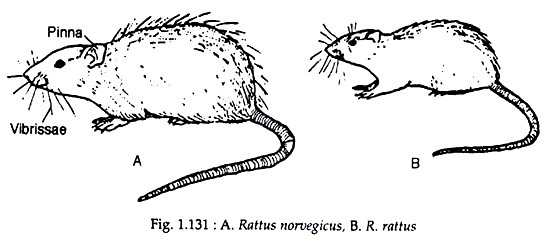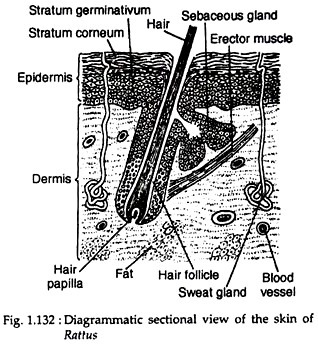In this article we will discuss about the external features of rattus norvegicus.
The body can be divided into head, short neck and trunk (Fig. 1.131). The whole body of Rattus Norvegicus is covered by gray hairs. The head is produced anteriorly into a blunt shout, which ends into a terminal mouth.
The upper lip has a vertical slit. The incisor teeth always remain exposed through this slit. External nares are present just above the mouth near the tip of the snout. Eyes are situated on the sides of the head.
The eyes possess movable upper and lower well developed eyelids. The nictitating membrane is supported by a semilunar cartilage and lies in the medial corner of each eye. The eye lashes are very fine and short.
ADVERTISEMENTS:
On the top of the head is a pair of short, rounded and movable external ears, the conch or pinna which is cartilage- nous. In certain regions of the head, thick, long, tactile sensory hairs, called vibrissae, are present (Fig. 1.131).
Head is joined to the trunk by a distinct neck. It permits free movement of the head in all directions. Trunk is divided into thorax and abdomen. The ventral surface of the females bears twelve nipple teats. Three pairs of which are in the thoracic region and are called pectoral teats, the other three pairs are abdominal in position and are called inguinal teats. On the posterior part of the ventral abdomen, three external openings are present—anus, vagina and urethra.
In the male, the testes descend during the breeding season into the thin-walled scrotal sac from the posterior abdominal region. Near the anterior end of the scrotum is the penis, containing the urinogenital opening. It is enclosed in a loose sheath, the prepuce. Tail is long, slender and covered by overlapping scales. From beneath each scale, three hairs and short bristles emerges out.
ADVERTISEMENTS:
The rat possesses two paired limbs—fore and hind limbs. Both the limbs are pentadactyle. The forelimb possesses backwardly directed upper arm or brachium and forwardly directed forearm or ante-brachium. The hand or manus comprises of a wrist or carpus, metacarpals and five digits with claws.
The thumb or polex is much reduced. The hand possess walking pads. The hind limbs are much longer than forelimbs. Each has a proximal thigh directed forward, a shank or curs directed backward and a distal foot or pes directed forward. The foot has an ankle or tarsus, metatarsals and five clawed digits.
Integumentary System:
The integument or skin of Rattus Norvegicus is made up of two layers: epidermis and dermis (Fig. 1.132).
Epidermis:
Epidermis is ectodermal in origin and it is the outermost layer of the body. The epidermis consists of following layers—A. Stratum corneum, B. Transitional layer, and C. Stratum germinativum.
A. Stratum Corneum:
This is the outer horny layer and is made up of dead cells. A protein, called keratin, gives the layer horny texture.
B. Transitional layer:
This is the second layer of the epidermis from the outside. It lies beneath the stratum corneum. It is made up of flat cells. These cells are derived from the stratum germinativum
C. Stratum germinativum:
The inner most layer of the epidermis is known as stratum germinativum or Malpighian layer. The cells of this layer are polyhedral in appearance and contain conspicuous nucleus and granules. These cells divide mitotically to form the upper layers.
ADVERTISEMENTS:
Dermis:
The dermis of Rattus Norvegicus is made up of loose connective tissue, blood vessels and nerves. In the dermis the following structures are present.
Hair follicle:
Epidermis penetrates into the dermis and forms small pocket called hair follicle. Hair papilla is located in the inner end of the follicle and the hair emerges from the papilla. Smooth muscles called erector muscles are associated with the papilla. These muscles raise the hair.
Sebaceous glands:
These are flask- shaped glands and they open into the hair papilla. The secretion of these glands is oily in nature and the name of the secretion is sebum. Sebum keeps the hair oily.
Sweat glands:
These are much coiled tube-like glands. The glands open to the outside through the epidermis. Secretion of these glands is known as sweat. Sweat is watery in nature. It helps in regulation of the body temperature and excretion.
Mammary glands:
These tubular and branched glands are well-developed and functional in adult females. The secretion of these glands is the milk which is taken by the suckling ones.

